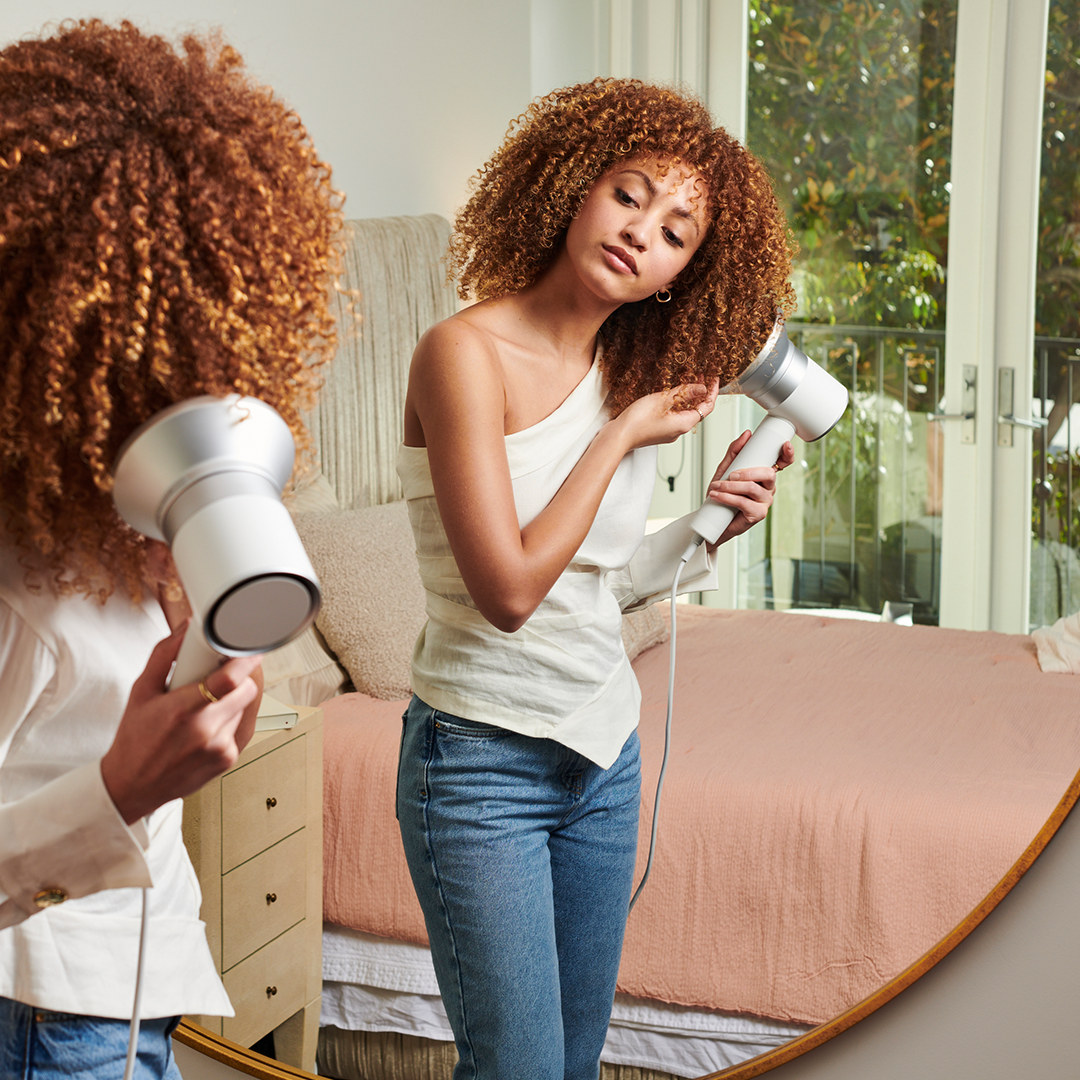What is a simple, yet effective way to achieve healthy and beautiful hair? Drying your hair at lower temperatures. In this article, we'll explore the many benefits of low-temperature hair drying, and why it's a better option compared to drying your hair at high and damaging temperatures. While high-heat blow-drying can lead to damage, frizz, and split ends, using lower temperatures offers a host of benefits that can truly transform your hair care routine. Discover the advantages of adopting this gentle approach to hair drying and how it can lead to healthier and more beautiful hair.
The Science Behind Hair Damage from High Heat
To understand the negative impact of high heat and the damage it can cause to hair, it's important to learn more about the structure of the hair, and how each layer is affected by high temperatures. Let's explore its three main layers: the cuticle, cortex, and medulla.
The Cuticle
The cuticle is the outermost layer of the hair shaft, consisting of overlapping, flat, and protective cells resembling shingles on a roof. It safeguards the inner layers of the hair, particularly the cortex. When the cuticle layer is intact and lays flat, it reflects light, giving the hair a shiny and healthy appearance.
However, exposure to excessive heat, such as high-temperature blow-drying, can damage the cuticle layer. The intense heat causes the cuticle to lift and become raised, leading to gaps and cracks in the protective shield. As a result, the inner layers of the hair become more vulnerable to environmental stressors, chemical treatments, and physical damage.
The Cortex
The cortex is the middle layer of the hair shaft, responsible for determining the hair's strength, elasticity, and color. It contains long chains of proteins called keratin, which give hair its structural integrity. The cortex also holds the natural pigments responsible for hair color.
When exposed to high temperatures during blow-drying, the water molecules within the cortex can become overheated. This excess heat causes keratin proteins to weaken and break down, resulting in a weakened hair structure. Additionally, prolonged exposure to high heat can lead to the loss of hair's natural moisture, making it more susceptible to dryness and breakage.
The Medulla
The medulla is the innermost layer of the hair shaft and is not always present in every hair strand. Its function remains unclear, as it doesn't significantly impact the hair's overall strength or appearance. In fact, many people have fine hair with no visible medulla.
While the medulla doesn't play a substantial role in heat vulnerability, the cortex and cuticle are critical to maintaining hair health. When subjected to high heat, the protective cuticle layer weakens, and the cortex, containing the hair's essential proteins, becomes more prone to damage.
Does hair type influence the hair's tolerance to high heat?
It's important to recognize that various hair types have different heat tolerance levels. Fine or damaged hair is more susceptible to heat damage, as it has a thinner cuticle layer and a weaker cortex. On the other hand, coarse or healthy hair might withstand heat better due to a thicker cuticle and a stronger cortex. Nevertheless, even the most resilient hair types can suffer damage from excessive heat over time.
What hair issues can high-heat drying and styling cause?
Excessive heat styling can cause a range of common hair issues, some of which can be quite damaging and difficult to repair. Here are the key hair problems associated with using high temperatures to dry or style your hair.
Dry and Brittle Hair
Frequent exposure to high heat from blow dryers, flat irons, and curling irons can strip the hair of its natural moisture. The heat evaporates the water content within the hair shaft, leaving it dry, brittle, and prone to breakage. The loss of moisture also results in a lack of shine and overall dullness of the hair.
Split Ends
Heat styling weakens the protective cuticle layer of the hair, making it more susceptible to split ends. The ends of the hair shaft can become frayed and split into two or more segments due to the loss of essential proteins and moisture. Split ends not only give hair an unkempt appearance but also hinder hair growth, as the damage can travel upward along the hair shaft.
Frizz and Flyaways
High heat disrupts the arrangement of the cuticle cells, causing them to lift and become rough. As a result, the hair loses its smoothness, and the lifted cuticles lead to frizz and flyaways. Frizzy hair can be particularly problematic for those with curly or wavy hair, as their hair structure is more prone to frizz due to increased surface area.
Loss of Hair Elasticity
Heat damages the protein structure of the hair, leading to a loss of elasticity. Hair that lacks elasticity is more prone to snapping and breaking when subjected to tension or styling. Over time, this can result in significant hair thinning and reduced volume.
Color Fading
If you have color-treated hair, excessive heat styling can cause the hair cuticle to open up, releasing the hair dye molecules. This results in rapid color fading and a shorter lifespan for your hair color. The loss of color vibrancy can lead to frequent touch-ups and potential damage from additional chemical treatments.
Loss of Texture and Curl Pattern
For people with natural curls or waves, excessive heat styling to straighten the hair can cause irreversible heat damage. Heat damage results in a loosening of natural curls or waves, leading to a loss of texture and definition in the hair.
Scalp Irritation and Dryness
The heat from hair styling tools can also affect the scalp, leading to irritation, dryness, and even flakiness. Prolonged exposure to high heat can disturb the scalp's natural balance and contribute to issues like dandruff.
How to Avoid the Damages of High Heat
Choose Low-heat Drying
By now, we all can agree that blasting our hair with extremely hot hair has negative consequences for the health of our hair and scalp. Low-heat hair drying is a hair care technique that involves using lower temperature settings on hair drying tools, such as hair dryers. Unlike traditional blow-drying, where high heat settings are commonly used to speed up the drying process, low-heat hair drying focuses on a more gentle and gradual approach to drying the hair. By using lower temperatures, this method aims to minimize the potential damage caused by excessive heat on the hair cuticle and cortex, as previously discussed.
The low heat hair drying method is especially beneficial for individuals with delicate or damaged hair, as it helps retain the hair's natural moisture, reduces frizz, and prevents split ends. By avoiding high heat, it can also be an effective way to protect color-treated hair, maintain natural curl patterns, and promote overall hair health and resilience.
Techniques & Tools for Low-heat Drying
To minimize heat damage, it's essential to adopt a lower-temperature approach when drying and styling hair. Doing so can help preserve the integrity of the cuticle layer and the essential proteins within the cortex, resulting in healthier, shinier, and more resilient hair. Let's look at a few low-heat options to incorporate into your haircare routine.
Choose a Hair Dryer with Lower Heat Settings
Investing in a high-quality hair dryer is essential for low-heat hair drying. Look for a dryer with smart settings that are optimized for hair health and known to use lower temperatures without compromising on performance. Additionally, some advanced dryers offer a cool shot button, which releases a blast of cool air to seal the hair cuticles after drying, further enhancing shine and reducing frizz. The award-winning Zuvi Halo is a great example of a low-heat hair dryer offering multiple smart settings, plus a cool shot, designed to prioritize hair health.
Use a Diffuser
Diffusers are attachments designed to disperse the airflow from a hair dryer, spreading it across a larger surface area. This helps to minimize direct heat exposure and reduce the risk of hair damage. Diffusers are particularly useful for those with curly or wavy hair, as they encourage the hair to maintain its natural texture and enhance curl definition.
Pre-Dry Using Microfiber Towels or T-shirts
Before using a hair dryer, gently blot excess moisture from your hair using a microfiber towel or a soft t-shirt. These materials are gentler on the hair than regular cotton towels, reducing friction and minimizing potential damage.
Consider Lower Wattage
Higher-wattage hair dryers can sometimes provide faster drying times, but they may also produce more heat. Opt for a hair dryer with lower wattage (for example, Zuvi Halo uses only 680w) to strike a balance between drying efficiency and heat control. A lower wattage can also lead to lower energy consumptions.
Ceramic or Infrared Heating
Hair dryers with ceramic or infrared heating elements distribute heat more evenly, reducing the risk of hot spots and potential damage to the hair. These technologies can be gentler on the hair and offer better control over the drying process. The LightCare™ technology used in the Zuvi Halo hair dryer is a great example of this, as it leverages beneficial infrared light to efficiently dry only the water on the surface of the hair, avoiding overheating and heat damage.
Read Reviews and Seek Recommendations
Before purchasing a hair dryer, read reviews from other customers to gauge its performance and heat levels. Additionally, seek recommendations from friends, family, or hair care professionals who may have experience with low-heat hair drying or specific hair dryer models.
Conclusion
Drying your hair at lower temperatures is a game-changer for hair care enthusiasts seeking to achieve healthy and beautiful locks. By understanding the science behind hair damage from high heat and adopting the low heat hair drying method, you can minimize frizz, split ends, and color fading while maintaining natural moisture and shine. Remember to be patient and prioritize and invest in the long-term health of your hair over quick drying times, and you'll be rewarded with radiant and manageable locks. Embrace this gentle approach to hair drying, and watch your hair become healthier and more beautiful day after day. Start your journey to healthier hair today!




Dejar un comentario
Todos los comentarios se revisan antes de su publicación.
Este sitio está protegido por hCaptcha y se aplican la Política de privacidad de hCaptcha y los Términos del servicio.